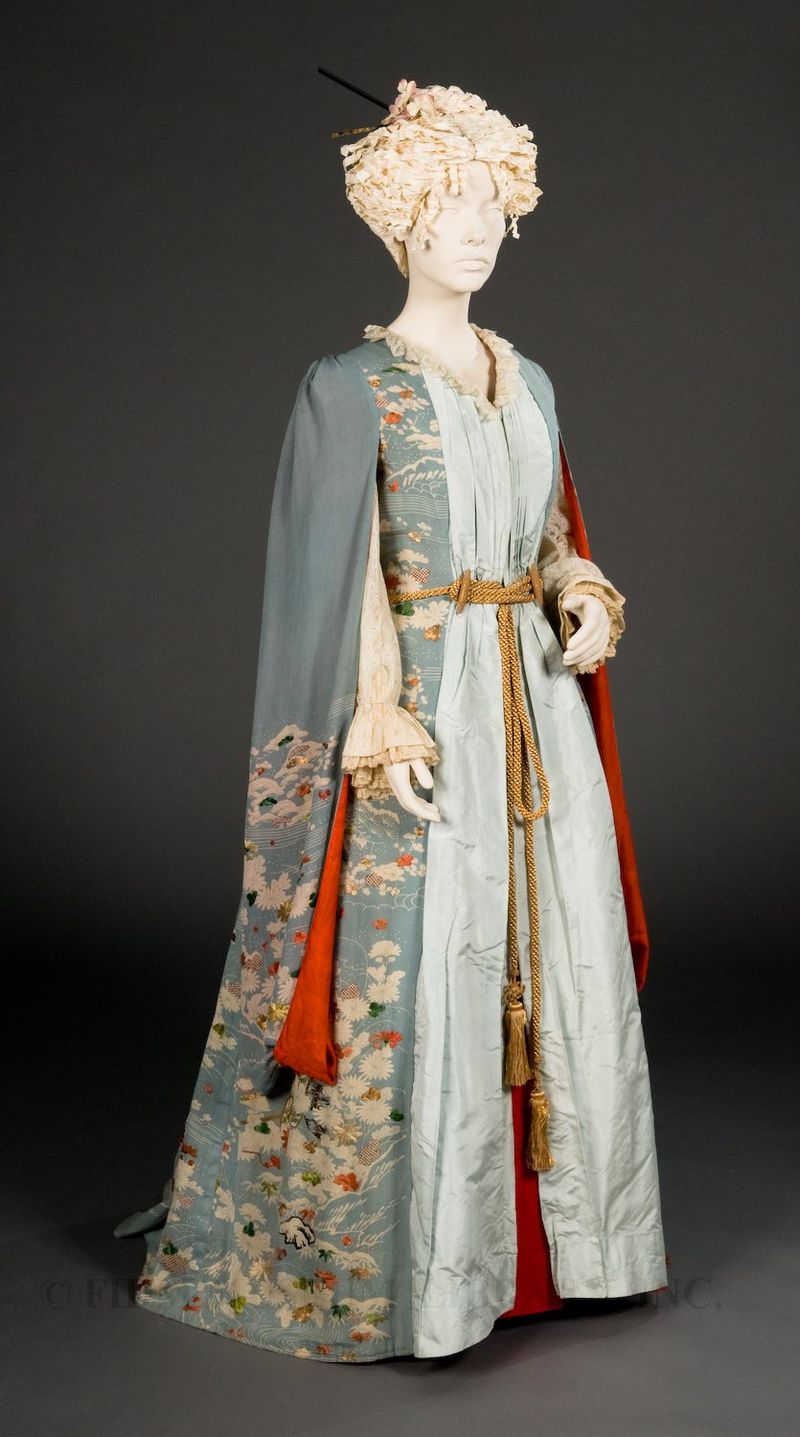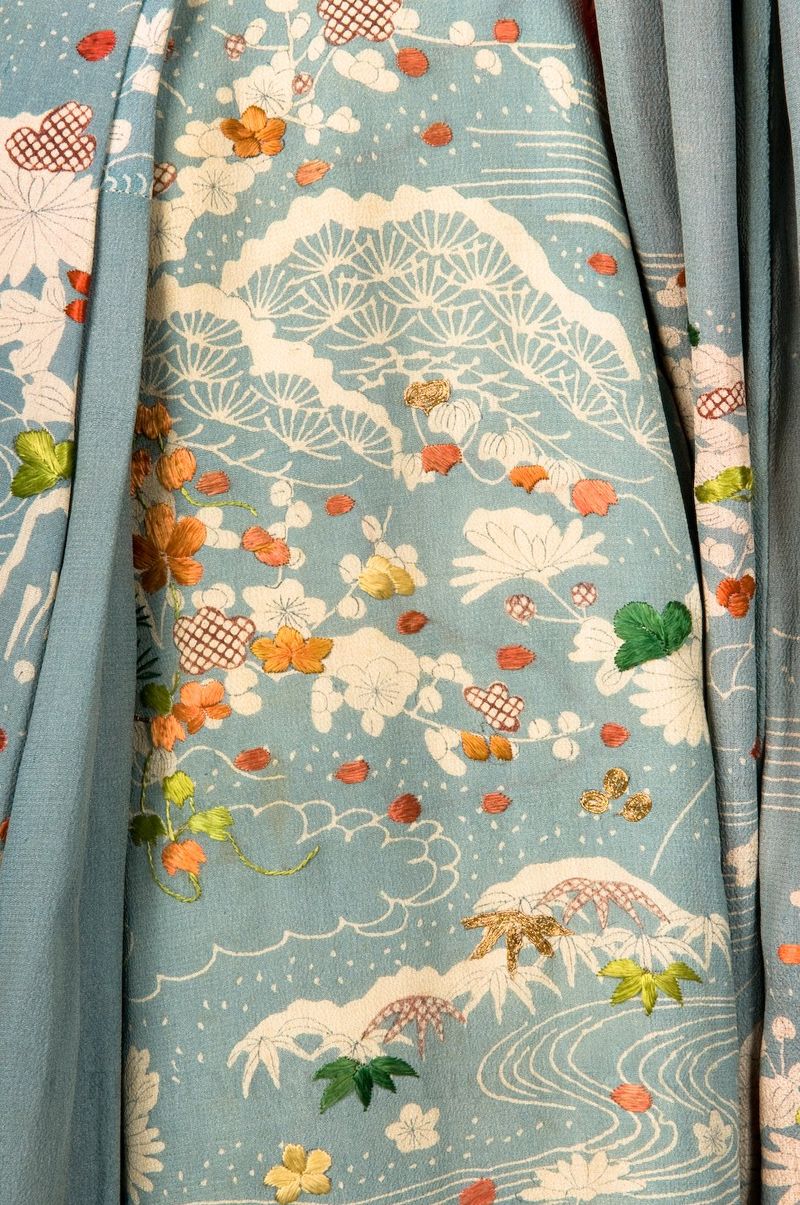
Kimono dressing gown
c. 1885
Gift of Anonymous Donor
80.40.1
Beginning in the late 19th century, Asian decorative arts, and those of Japan in particular, had a tremendous impact on Western culture. Many Americans and Europeans traveled to Japan, often returning with textiles and garments that were soon converted to familiar Western garments. This blue dressing gown began as a Japanese furisode, or “swinging sleeves” kimono, a type worn only by young unmarried women. It is a particularly creative example of how Japanese dress could be transformed into fashionable Western dress. Through the addition of princess seams, lace undersleeves and inserts of pale-blue taffeta at front and back, the furisode kimono became a stylish Western dressing gown, complete with bustle. Regardless of these Western elements, the dressing gown is strongly evocative of Japan, particularly in its retention of the crimson lining often found in women’s kimonos.
The white and blue pattern was created using the katazome technique. Katazome is a type of resist dying in which a stencil is used to apply rice paste to the areas of fabric which will remain white. When the rice paste dries, the fabric is dyed. The katazome process usually results in fabrics with only 2 colors: white and the color that has been overdyed. Further embellishment often takes the form of multi-colored embroidery. Here, rust, gold and green silk floss and metallic gold thread were used to embroider specific motifs at random. The darker cross-hatch pattern was hand-painted.




Wow! This is a stunning piece of art. I think I like the colorful embroidery the most, but that rice paste stencil technique is really something too.
Interesting! I’d never thought of doing something like this with a kimono (I guess I’m too in love with the lines of a kimono, and cutting one up just feels barbaric), but this is a really cool re-purposing of one for Western-style dress. I think my favorite part is the fact that the two center back pieces of the bodice were cut with the fabric upside down. Makes me wonder if that was the only way they could get those pieces cut from what was left of the kimono, or if it was a mistake.
Also, I’d always associated red lining with uchikake, and white (or other more muted colors) with furisode. Granted, most of the kimono I’ve seen were made from the 1950s onward, so maybe the style has changed. The patterning on this kimono does look more like a furisode, and isn’t nearly as elaborately decorated as the uchikake I’ve seen. (Plus, there’s no cranes in the design.) I guess this means I need to do some more research! 🙂
Katrina, I can tell from your comment that you’ve got an interest in kimonos! I’m glad you pointed out the issue with the pattern being upside down. I like that aspect too!
Kimonos are created with a minimal amount of cutting and stitching from lengths of fabric about 14″ wide. There is typically no shoulder seam, i.e. the length of fabric starts at the lower front hem, continues over the shoulder and down to the lower back hem. Because of this, you often get a reversed pattern on the back. It definitely wasn’t a mistake on the part of the maker of this dressing gown. He or she was simply working with the natural structure of the kimono.
As for the lining, I think the concern would have been what coordinated well with the outer fabric. The color of red seen here wouldn’t have been an unusual choice. Though contemporary kimono linings are perhaps more dictated by convention than taste, this wasn’t always the case.
You can always tell an uchikake by it’s padded hem! An uchikake is really a ceremonial garment, meant to be worn over another kimono at a wedding or other formal event. They’re worn almost like an open coat, with the kimono underneath meant to be seen. As you pointed out, the patterns and embellishment of uchikake are often very elaborate.
Yeah, I’m a bit of a kimono junkie. 🙂 I just think it’s funny that the center back pieces are still upside down in this dress even though there are now shoulder seams on the garment. It makes me wonder if the designer of this gown deliberately wanted to keep the design upside down like in the original…well, at least on part of the back, since the design on the side back and the bustled skirt are oriented the other way. Or, maybe he just stitched a quick shoulder seam into the body pieces without cutting separate pieces for the front and back of the gown. Or…maybe I’m just overthinking things and he cut the backs the wrong way by mistake. (hehe)
Wow – that’s really cool. I am also a kimono junkie! Japanese fabrics are so beautiful.
Beautiful! Any idea if there are patterns or instructions on how to do something like this? I would love to try it but I am not good at drafting my own patterns.
If you’re interested in making something like this yourself, I’d suggest looking at issues of Harper’s Bazaar, Lady’s Home Journal, etc., from the 1880s. Patterns were an important part of fashion periodicals in the late 19th century, so you might find something similar.
I’ve never seen a pattern for something exactly like this, but I’ve definitely seen patterns for a variety of dressing gowns. Good luck!
Red linings were much more common pre-WW2; it’s kind of a dead giveaway for early 20th century kimono.
I have been wanting to make a bustle gown out of Japanese textiles for awhile (steampunk ahoy!) but the cutting a kimono part will hurt…
Beautifull kimonos. Not many people know that the kimono was the inspiration for the silk dressing gown we know today.